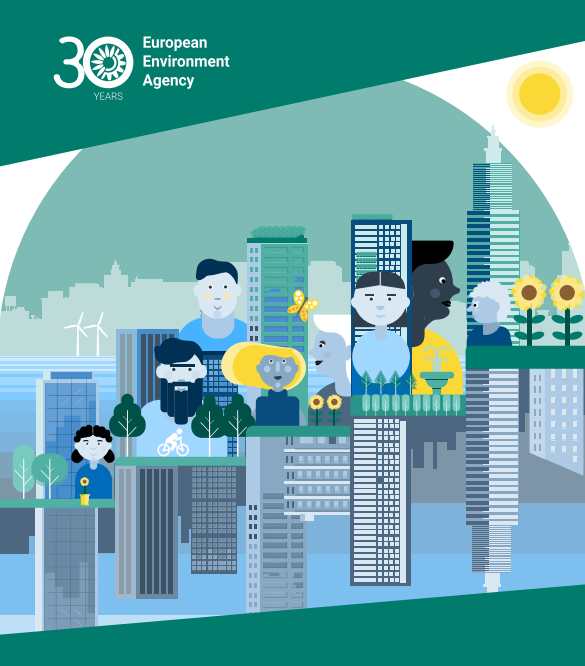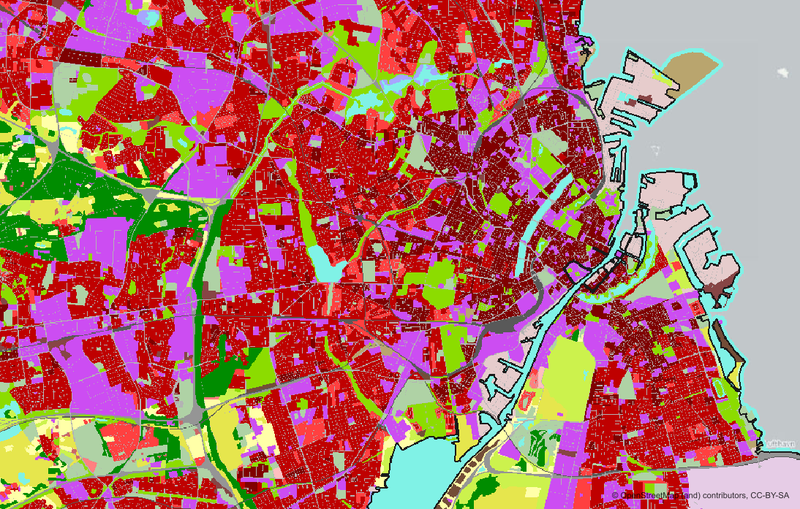All official European Union website addresses are in the europa.eu domain.
See all EU institutions and bodiesUrban areas often have high population densities, intricate transport networks and dense commercial and industrial areas, which can compound existing environmental and health issues, and exacerbate social inequalities. At the same time, cities have the capacity to shape the transition to a more sustainable future.
About three-quarters of Europeans live in cities, according to UN-Habitat. Cities, with their concentrated population and infrastructure, are especially vulnerable to certain effects of climate change and other environmental stresses like heatwaves, flash floods, pollution, noise, and soil contamination. Their aggregated consumption patterns can also lead to biodiversity loss. According to our estimates, in 2022, 96% of people living in EU cities were exposed to levels of air pollution by fine particulate matter (PM2.5) above the WHO guideline.
Also, building stock accounts for 40% of energy consumption and 36% of GHG emissions. At present, 75% of the European building stock is energy inefficient.
All these aspects have a disproportionate impact on vulnerable segments of the population and can exacerbate social challenges like segregation, poverty and inequality.
At the same time, however, cities are hubs of creativity, innovation and education, and have the capacity to affect significant systemic changes across a range of critical environmental issues. Cities have their own governments and are often best placed for local action to tackle and resolve environmental challenges. Historically, municipalities have played a crucial role in improving waste, wastewater and water management, public transport and land use via integrated urban planning approaches. Today, they have an increasingly central role in tackling climate change mitigation and adaptation, ecosystem preservation and restoration and circular economy. In addition, the presence of accessible, high-quality green spaces in cities supports physical and mental health and social well-being.
Still, more must be done to create truly sustainable European cities. Recent EU policies aim to enhance cities’ resilience and their capacity to transition towards sustainability.

Addressing the environmental and climate footprint of buildings
Construction, use and demolition of buildings causes major environment and climate pressures but smart renovations that focus on efficient use of energy and resources can help Europe increase the sustainability of its housing sector, according to a European Environment Agency report.
Ageing populations, increasing affluence and changing climate are expected to change demands for buildings’ particular uses in Europe, the EEA report notes. More buildings are likely to be needed in cities, and buildings need to contribute to environment and climate solutions, including energy saving and production, protection from climate hazards, and restoring nature.
Cities are key to a climate-resilient Europe
The EEA report ‘Urban adaptation in Europe’ highlights the urgent need to adapt European cities to climate change and provides an overview of actions they are taking.
As European cities increasingly feel the impacts of climate change, such as heatwaves and floods, there is a clear case for investing in urban societal resilience, the EEA report states. Cities have an essential role in the implementation of adaptation actions.
European cities are adapting to climate change through a wide range of effective actions, including urban planning and building codes, economic incentives and insurance, early-warning systems and information campaigns. Emerging areas of opportunity for adaptation include promoting urban agriculture, creating more liveable public spaces and protecting cultural heritage.
They are also increasingly implementing nature-based solutions, which are included in 91% of local adaptation plans analysed in the report.


EEA's conceptual framework for urban sustainability
Europe is a highly urbanised continent. The urban landscape of Europe is heterogenous and characterised by a diversity of mostly small and medium cities.
Despite this diversity, it is clear that cities will need to play a key role in achieving sustainability in Europe.
With the support of urban stakeholders, the EEA developed a conceptual model and selected six observation and analysis lenses to assess the role of cities in urban transitions towards environmental sustainability, within the broad European Green Deal framework and the EU Urban Agenda.
How can Copernicus Help?
Cities have an outsized environmental impact, both positive and negative. On the one hand, urban sprawl encroaches on natural habitats and generates large amounts of pollution. On the other hand, resource use is typically more efficient and large-scale infrastructure projects can result in a lower environmental impact per person.
As such, the importance of effective urban planning is hard to overstate. Every decision about how we use the land in urban spaces can either improve peoples’ lives and reduce our impact on the environment or have precisely the opposite effect. The Urban Atlas suite of products gives users access to detailed land cover/land use maps for 788 Functional Urban Areas across Europe, as well as additional street tree maps, building block height measurements, and population estimates. These products provide information necessary for urban planners to make informed, data-driven decisions about things like green spaces, transportation networks, and emergency response plans.

Which European city has the cleanest air? What about your city?
Islands in cities: heat islands
In cities, the ground is often covered by asphalt, pavement and buildings, which absorb and retain heat. The temperature is higher and that becomes dangerous for health. This is the urban heat island effect.
Increasingly frequent, long and intense heatwaves in combination with an ageing population and growing urbanisation mean that more vulnerable populations are exposed to high temperatures, particularly in southern and central Europe.
Reducing the health impacts of heat requires implementing a wide range of solutions, including effective heat health action plans, creating more green and shaded areas in cities, appropriate building design and construction, and adjusting working times and conditions so people are less exposed.

Unequal access to green areas
Environmental inequalities in cities are reflected in the levels of pollution and noise that people are facing, but also even in the access to green areas, which offer great benefits for children and the elderly:
- Cities in the north and west of Europe have more total green space within their area than cities in southern and eastern Europe.
- Within cities, the degree of greening varies across neighbourhoods, with less and lower quality green space typically found in communities of lower socio-economic status.
